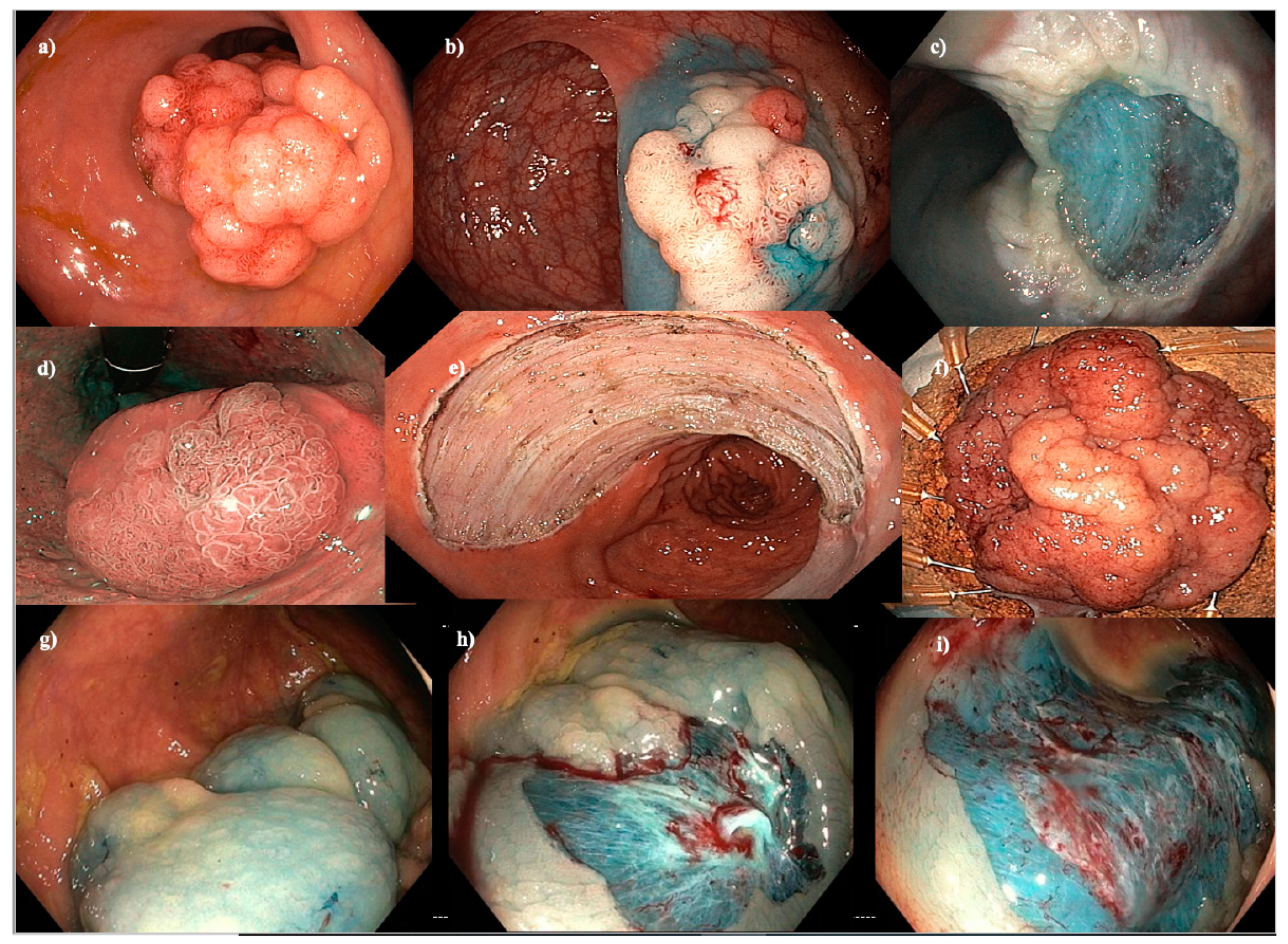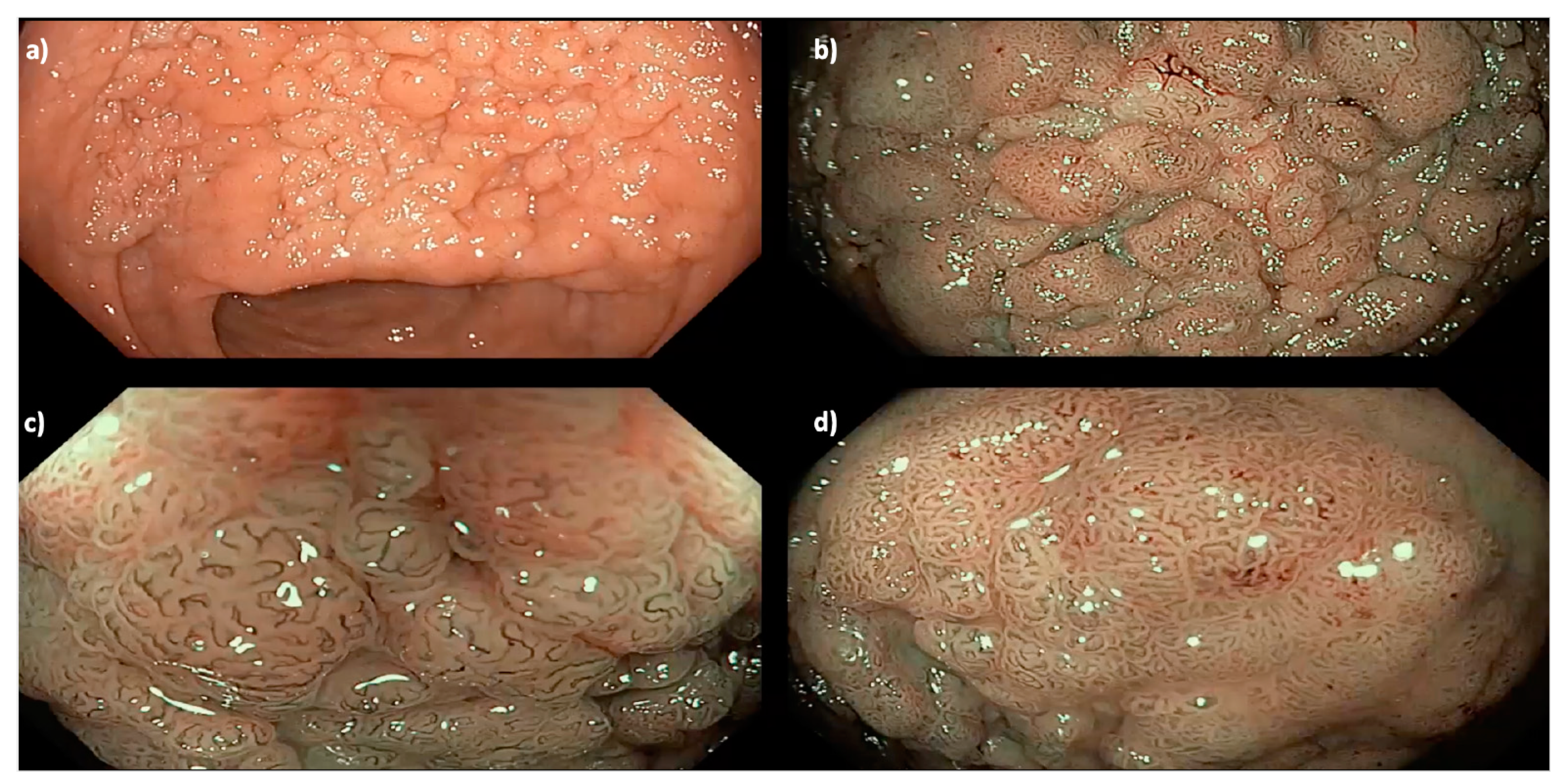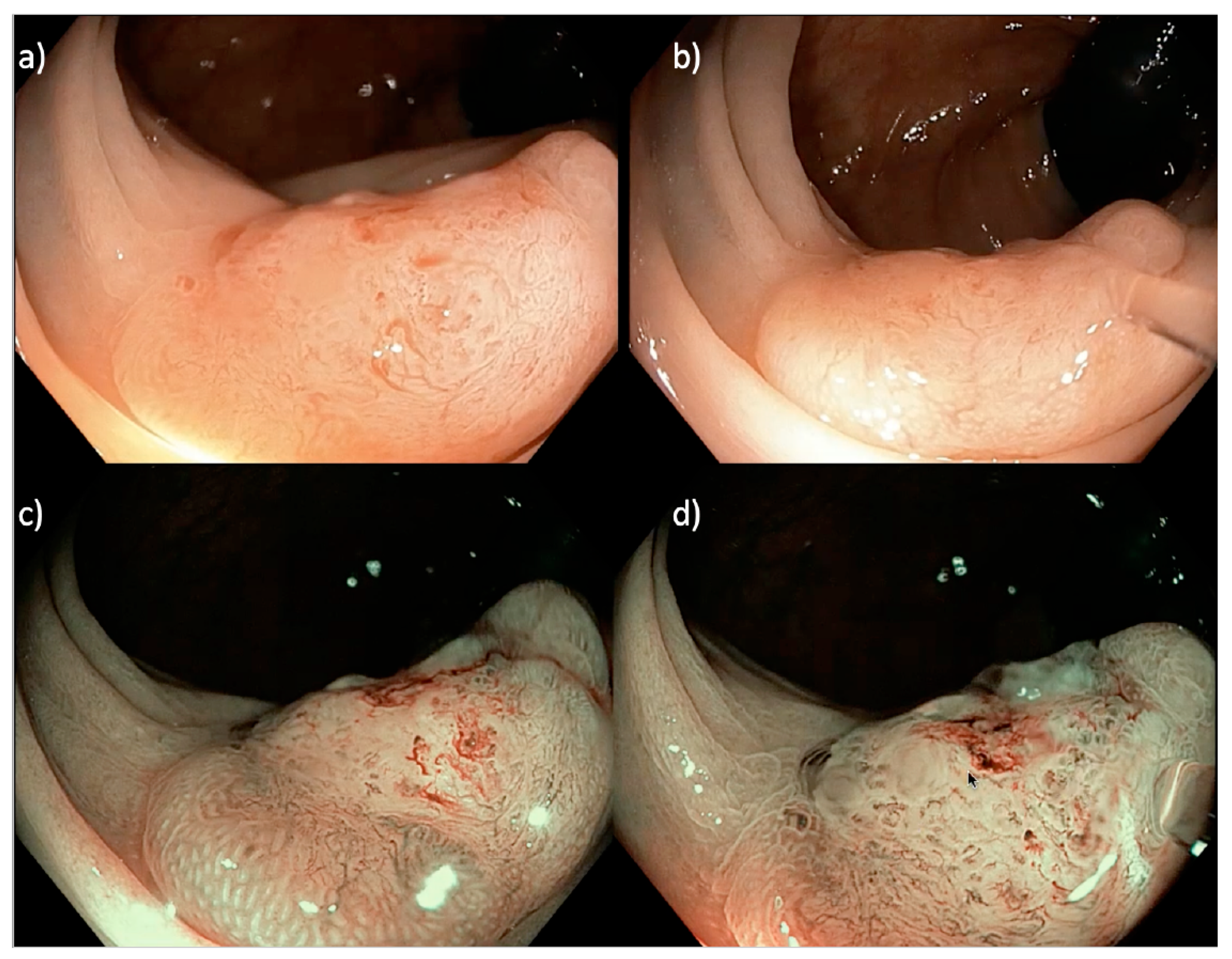Endoscopic Management of Large Non-Pedunculated Colorectal Polyps
Abstract
:Simple Summary
Abstract
1. Introduction
2. Pre-Resection
3. Resection
3.1. Diminutive (<5 mm) and Small (5–9 mm) Colorectal Polyps
3.2. Medium (10–19 mm) Colorectal Polyps
3.3. Large (>20 mm) Non-Pedunculated Colorectal Polyps
3.4. Special Considerations
3.5. Complications
3.5.1. Deep Mural Injury
3.5.2. Post-Procedural Bleeding
4. Post-Resection
4.1. Post-Operative Care
4.2. Surveillance
5. Conclusions
Author Contributions
Funding
Conflicts of Interest
References
- Keum, N.; Giovannucci, E. Global burden of colorectal cancer: Emerging trends, risk factors and prevention strategies. Nat. Rev. Gastroenterol. Hepatol. 2019, 16, 713–732. [Google Scholar] [CrossRef]
- Patel, S.G.; Karlitz, J.J.; Yen, T.; Lieu, C.H.; Boland, C.R. The rising tide of early-onset colorectal cancer: A comprehensive review of epidemiology, clinical features, biology, risk factors, prevention, and early detection. Lancet Gastroenterol. Hepatol. 2022, 7, 262–274. [Google Scholar] [CrossRef]
- Levin, B.; Lieberman, D.A.; McFarland, B.; Andrews, K.S.; Brooks, D.; Bond, J.; Dash, C.; Giardiello, F.M.; Glick, S.; Johnson, D.; et al. Screening and surveillance for the early detection of colorectal cancer and adenomatous polyps, 2008: A joint guideline from the American Cancer Society, the US Multi-Society Task Force on Colorectal Cancer, and the American College of Radiology. Gastroenterology 2008, 134, 1570–1595. [Google Scholar] [CrossRef] [PubMed] [Green Version]
- Kedrin, D.; Gala, M.K. Genetics of the serrated pathway to colorectal cancer. Clin. Transl. Gastroenterol. 2015, 6, e84. [Google Scholar] [CrossRef] [PubMed]
- Itzkowitz, S.H.; Yio, X. Inflammation and cancer IV. Colorectal cancer in inflammatory bowel disease: The role of inflammation. Am. J. Physiol. Gastrointest. Liver Physiol. 2004, 287, G7–G17. [Google Scholar] [CrossRef] [PubMed]
- Winawer, S.J.; Zauber, A.G.; Ho, M.N.; O’Brien, M.J.; Gottlieb, L.S.; Sternberg, S.S.; Waye, J.D.; Schapiro, M.; Bond, J.H.; Panish, J.F.; et al. Prevention of colorectal cancer by colonoscopic polypectomy. The National Polyp Study Workgroup. N. Engl. J. Med. 1993, 329, 1977–1981. [Google Scholar] [CrossRef]
- Zauber, A.G.; Winawer, S.J.; O’Brien, M.J.; Lansdorp-Vogelaar, I.; van Ballegooijen, M.; Hankey, B.F.; Shi, W.; Bond, J.H.; Schapiro, M.; Panish, J.F.; et al. Colonoscopic polypectomy and long-term prevention of colorectal-cancer deaths. N. Engl. J. Med. 2012, 366, 687–696. [Google Scholar] [CrossRef]
- Kahi, C.J.; Imperiale, T.F.; Juliar, B.E.; Rex, D.K. Effect of screening colonoscopy on colorectal cancer incidence and mortality. Clin. Gastroenterol. Hepatol. 2009, 7, 770–775, quiz 711. [Google Scholar] [CrossRef]
- Bretthauer, M.; Løberg, M.; Wieszczy, P.; Kalager, M.; Emilsson, L.; Garborg, K.; Rupinski, M.; Dekker, E.; Spaander, M.; Bugajski, M.; et al. Effect of Colonoscopy Screening on Risks of Colorectal Cancer and Related Death. N. Engl. J. Med. 2022, 387, 1547–1556. [Google Scholar] [CrossRef]
- Rex, D.K. Have we defined best colonoscopic polypectomy practice in the United States? Clin. Gastroenterol. Hepatol. 2007, 5, 674–677. [Google Scholar] [CrossRef]
- Gupta, N.; Bansal, A.; Rao, D.; Early, D.S.; Jonnalagadda, S.; Wani, S.B.; Edmundowicz, S.A.; Sharma, P.; Rastogi, A. Prevalence of advanced histological features in diminutive and small colon polyps. Gastrointest. Endosc. 2012, 75, 1022–1030. [Google Scholar] [CrossRef]
- Repici, A.; Hassan, C.; Vitetta, E.; Ferrara, E.; Manes, G.; Gullotti, G.; Princiotta, A.; Dulbecco, P.; Gaffuri, N.; Bettoni, E.; et al. Safety of cold polypectomy for <10 mm polyps at colonoscopy: A prospective multicenter study. Endoscopy 2012, 44, 27–31. [Google Scholar] [PubMed]
- Burgess, N.G.; Hourigan, L.F.; Zanati, S.A.; Brown, G.J.; Singh, R.; Williams, S.J.; Raftopoulos, S.C.; Ormonde, D.; Moss, A.; Byth, K.; et al. Risk Stratification for Covert Invasive Cancer Among Patients Referred for Colonic Endoscopic Mucosal Resection: A Large Multicenter Cohort. Gastroenterology 2017, 153, 732–742.e1. [Google Scholar] [CrossRef] [Green Version]
- Holt, B.A.; Bourke, M.J. Wide field endoscopic resection for advanced colonic mucosal neoplasia: Current status and future directions. Clin. Gastroenterol. Hepatol. 2012, 10, 969–979. [Google Scholar] [CrossRef]
- Vosko, S.; Shahidi, N.; Sidhu, M.; van Hattem, W.A.; Bar-Yishay, I.; Schoeman, S.; Tate, D.J.; Hourigan, L.F.; Singh, R.; Moss, A.; et al. Optical evaluation for predicting cancer in large non-pedunculated colorectal polyps is accurate for flat lesions. Clin. Gastroenterol. Hepatol. 2021, 19, 2425–2434. [Google Scholar] [CrossRef]
- Shahidi, N.; Vosko, S.; Gupta, S.; Whitfield, A.; Cronin, O.; O’Sullivan, T.; van Hattem, W.A.; Sidhu, M.; Tate, D.J.; Lee, E.Y.T.; et al. A Rectum-Specific Selective Resection Algorithm Optimizes Oncologic Outcomes for Large Nonpedunculated Rectal Polyps. Clin. Gastroenterol. Hepatol. 2023, 21, 72–80.e2. [Google Scholar] [CrossRef]
- Shahidi, N.; Bourke, M.J. How to Manage the Large Nonpedunculated Colorectal Polyp. Gastroenterology 2021, 160, 2239–2243.e2231. [Google Scholar] [CrossRef] [PubMed]
- Kaltenbach, T.; Anderson, J.C.; Burke, C.A.; Dominitz, J.A.; Gupta, S.; Lieberman, D.; Robertson, D.J.; Shaukat, A.; Syngal, S.; Rex, D.K. Endoscopic Removal of Colorectal Lesions: Recommendations by the US Multi-Society Task Force on Colorectal Cancer. Am. J. Gastroenterol. 2020, 115, 435–464. [Google Scholar] [CrossRef]
- Ferlitsch, M.; Moss, A.; Hassan, C.; Bhandari, P.; Dumonceau, J.M.; Paspatis, G.; Jover, R.; Langner, C.; Bronzwaer, M.; Nalankilli, K.; et al. Colorectal polypectomy and endoscopic mucosal resection (EMR): European Society of Gastrointestinal Endoscopy (ESGE) Clinical Guideline. Endoscopy 2017, 49, 270–297. [Google Scholar] [CrossRef] [PubMed]
- Jayanna, M.; Burgess, N.G.; Singh, R.; Hourigan, L.F.; Brown, G.J.; Zanati, S.A.; Moss, A.; Lim, J.; Sonson, R.; Williams, S.J.; et al. Cost Analysis of Endoscopic Mucosal Resection vs Surgery for Large Laterally Spreading Colorectal Lesions. Clin. Gastroenterol. Hepatol. 2016, 14, 271–278.e2. [Google Scholar] [CrossRef]
- Ahlenstiel, G.; Hourigan, L.F.; Brown, G.; Zanati, S.; Williams, S.J.; Singh, R.; Moss, A.; Sonson, R.; Bourke, M.J. Actual endoscopic versus predicted surgical mortality for treatment of advanced mucosal neoplasia of the colon. Gastrointest. Endosc. 2014, 80, 668–676. [Google Scholar] [CrossRef] [PubMed]
- Jideh, B.; Bourke, M.J. How to Perform Wide-Field Endoscopic Mucosal Resection and Follow-up Examinations. Gastrointest. Endosc. Clin. N. Am. 2019, 29, 629–646. [Google Scholar] [CrossRef] [PubMed]
- Holt, B.A.; Bassan, M.S.; Sexton, A.; Williams, S.J.; Bourke, M.J. Advanced mucosal neoplasia of the anorectal junction: Endoscopic resection technique and outcomes (with videos). Gastrointest. Endosc. 2014, 79, 119–126. [Google Scholar] [CrossRef] [PubMed]
- Shahidi, N.; Sidhu, M.; Vosko, S.; van Hattem, W.A.; Bar-Yishay, I.; Schoeman, S.; Tate, D.J.; Holt, B.; Hourigan, L.F.; Lee, E.Y.; et al. Endoscopic mucosal resection is effective for laterally spreading lesions at the anorectal junction. Gut 2020, 69, 673–680. [Google Scholar] [CrossRef]
- Bassan, M.S.; Holt, B.; Moss, A.; Williams, S.J.; Sonson, R.; Bourke, M.J. Carbon dioxide insufflation reduces number of postprocedure admissions after endoscopic resection of large colonic lesions: A prospective cohort study. Gastrointest. Endosc. 2013, 77, 90–95. [Google Scholar] [CrossRef] [PubMed]
- Cronin, O.; Sidhu, M.; Shahidi, N.; Gupta, S.; O’Sullivan, T.; Whitfield, A.; Wang, H.; Kumar, P.; Hourigan, L.F.; Byth, K.; et al. Comparison of the morphology and histopathology of large nonpedunculated colorectal polyps in the rectum and colon: Implications for endoscopic treatment. Gastrointest. Endosc. 2022, 96, 118–124. [Google Scholar]
- Kudo, S.; Tamura, S.; Nakajima, T.; Yamano, H.; Kusaka, H.; Watanabe, H. Diagnosis of colorectal tumorous lesions by magnifying endoscopy. Gastrointest. Endosc. 1996, 44, 8–14. [Google Scholar] [CrossRef]
- Sano, Y.; Tanaka, S.; Kudo, S.E.; Saito, S.; Matsuda, T.; Wada, Y.; Fujii, T.; Ikematsu, H.; Uraoka, T.; Kobayashi, N.; et al. Narrow-band imaging (NBI) magnifying endoscopic classification of colorectal tumors proposed by the Japan NBI Expert Team. Dig. Endosc. 2016, 28, 526–533. [Google Scholar] [CrossRef]
- Chang, L.C.; Shun, C.T.; Hsu, W.F.; Tu, C.H.; Chen, C.C.; Wu, M.S.; Chiu, H.M. Risk of delayed bleeding before and after implementation of cold snare polypectomy in a screening colonoscopy setting. Endosc. Int. Open 2019, 7, E232–E238. [Google Scholar] [CrossRef] [Green Version]
- Tolliver, K.A.; Rex, D.K. Colonoscopic polypectomy. Gastroenterol. Clin. N. Am. 2008, 37, 229–251+ix. [Google Scholar] [CrossRef]
- Rex, D.K.; Anderson, J.C.; Pohl, H.; Lahr, R.E.; Judd, S.; Antaki, F.; Lilley, K.; Castelluccio, P.F.; Vemulapalli, K.C. Cold versus hot snare resection with or without submucosal injection of 6- to 15-mm colorectal polyps: A randomized controlled trial. Gastrointest. Endosc. 2022, 96, 330–338. [Google Scholar] [PubMed]
- Bourke, M.J.; Bhandari, P. How I remove polyps larger than 20 mm. Gastrointest. Endosc. 2019, 90, 877–880. [Google Scholar] [CrossRef] [PubMed]
- Moss, A.; Bourke, M.J.; Metz, A.J. A randomized, double-blind trial of succinylated gelatin submucosal injection for endoscopic resection of large sessile polyps of the colon. Am. J. Gastroenterol. 2010, 105, 2375–2382. [Google Scholar] [CrossRef]
- Klein, A.; Tate, D.J.; Jayasekeran, V.; Hourigan, L.; Singh, R.; Brown, G.; Bahin, F.F.; Burgess, N.; Williams, S.J.; Lee, E.; et al. Thermal Ablation of Mucosal Defect Margins Reduces Adenoma Recurrence After Colonic Endoscopic Mucosal Resection. Gastroenterology 2019, 156, 604–613.e3. [Google Scholar] [CrossRef] [Green Version]
- Sidhu, M.; Shahidi, N.; Gupta, S.; Desomer, L.; Vosko, S.; Arnout van Hattem, W.; Hourigan, L.F.; Lee, E.Y.T.; Moss, A.; Raftopoulos, S.; et al. Outcomes of Thermal Ablation of the Mucosal Defect Margin After Endoscopic Mucosal Resection: A Prospective, International, Multicenter Trial of 1000 Large Nonpedunculated Colorectal Polyps. Gastroenterology 2021, 161, 163–170.e163. [Google Scholar]
- van Hattem, W.A.; Shahidi, N.; Vosko, S.; Hartley, I.; Britto, K.; Sidhu, M.; Bar-Yishay, I.; Schoeman, S.; Tate, D.J.; Byth, K.; et al. Piecemeal cold snare polypectomy versus conventional endoscopic mucosal resection for large sessile serrated lesions: A retrospective comparison across two successive periods. Gut 2021, 70, 1691–1697. [Google Scholar]
- Nanda, K.S.; Tutticci, N.; Burgess, N.G.; Sonson, R.; Williams, S.J.; Bourke, M.J. Endoscopic mucosal resection of laterally spreading lesions involving the ileocecal valve: Technique, risk factors for failure, and outcomes. Endoscopy 2015, 47, 710–718. [Google Scholar] [PubMed]
- Vosko, S.; Gupta, S.; Shahidi, N.; van Hattem, W.A.; Zahid, S.; McKay, O.; Whitfield, A.; Sidhu, M.; Tate, D.J.; Lee, E.Y.T.; et al. Impact of technical innovations in EMR in the treatment of large nonpedunculated polyps involving the ileocecal valve (with video). Gastrointest. Endosc. 2021, 94, 959–968.e2. [Google Scholar] [CrossRef]
- Tate, D.J.; Desomer, L.; Awadie, H.; Goodrick, K.; Hourigan, L.; Singh, R.; Williams, S.J.; Bourke, M.J. EMR of laterally spreading lesions around or involving the appendiceal orifice: Technique, risk factors for failure, and outcomes of a tertiary referral cohort (with video). Gastrointest. Endosc. 2018, 87, 1279–1288.e2. [Google Scholar] [CrossRef] [Green Version]
- Bar-Yishay, I.; Shahidi, N.; Gupta, S.; Vosko, S.; van Hattem, W.A.; Schoeman, S.; Sidhu, M.; Tate, D.J.; Hourigan, L.F.; Singh, R.; et al. Outcomes of Deep Mural Injury After Endoscopic Resection: An International Cohort of 3717 Large Non-Pedunculated Colorectal Polyps. Clin. Gastroenterol. Hepatol. 2022, 20, e139–e147. [Google Scholar]
- Vennix, S.; Pelzers, L.; Bouvy, N.; Beets, G.L.; Pierie, J.P.; Wiggers, T.; Breukink, S. Laparoscopic versus open total mesorectal excision for rectal cancer. Cochrane Database Syst. Rev. 2014, Cd005200. [Google Scholar] [CrossRef] [Green Version]
- Duran, E.; Tanriseven, M.; Ersoz, N.; Oztas, M.; Ozerhan, I.H.; Kilbas, Z.; Demirbas, S. Urinary and sexual dysfunction rates and risk factors following rectal cancer surgery. Int. J. Color. Dis. 2015, 30, 1547–1555. [Google Scholar] [CrossRef] [PubMed]
- Celentano, V.; Cohen, R.; Warusavitarne, J.; Faiz, O.; Chand, M. Sexual dysfunction following rectal cancer surgery. Int. J. Color. Dis. 2017, 32, 1523–1530. [Google Scholar] [CrossRef]
- Climent, M.; Martin, S.T. Complications of laparoscopic rectal cancer surgery. Mini-Invasive Surg. 2018, 2, 45. [Google Scholar] [CrossRef]
- Lindgren, R.; Hallböök, O.; Rutegård, J.; Sjödahl, R.; Matthiessen, P. What is the risk for a permanent stoma after low anterior resection of the rectum for cancer? A six-year follow-up of a multicenter trial. Dis. Colon. Rectum 2011, 54, 41–47. [Google Scholar] [CrossRef]
- Cuccurullo, D.; Pirozzi, F.; Sciuto, A.; Bracale, U.; La Barbera, C.; Galante, F.; Corcione, F. Relaparoscopy for management of postoperative complications following colorectal surgery: Ten years experience in a single center. Surg. Endosc. 2015, 29, 1795–1803. [Google Scholar] [CrossRef]
- Mulita, F.; Liolis, E.; Akinosoglou, K.; Tchabashvili, L.; Maroulis, I.; Kaplanis, C.; Vailas, M.; Panos, G. Postoperative sepsis after colorectal surgery: A prospective single-center observational study and review of the literature. Prz. Gastroenterol. 2022, 17, 47–51. [Google Scholar] [PubMed]
- Gibson, D.J.; Sidhu, M.; Zanati, S.; Tate, D.J.; Mangira, D.; Moss, A.; Singh, R.; Hourigan, L.F.; Raftopoulos, S.; Pham, A.; et al. Oncological outcomes after piecemeal endoscopic mucosal resection of large non-pedunculated colorectal polyps with covert submucosal invasive cancer. Gut 2022, 71, 2481–2488. [Google Scholar] [CrossRef]
- Shahidi, N.; Vosko, S.; Gupta, S.; van Hattem, W.A.; Sidhu, M.; Tate, D.J.; Williams, S.J.; Lee, E.Y.T.; Burgess, N.; Bourke, M.J. Previously Attempted Large Nonpedunculated Colorectal Polyps Are Effectively Managed by Endoscopic Mucosal Resection. Am. J. Gastroenterol. 2021, 116, 958–966. [Google Scholar] [CrossRef]
- Burgess, N.G.; Bassan, M.S.; McLeod, D.; Williams, S.J.; Byth, K.; Bourke, M.J. Deep mural injury and perforation after colonic endoscopic mucosal resection: A new classification and analysis of risk factors. Gut 2017, 66, 1779–1789. [Google Scholar] [CrossRef]
- Bahin, F.F.; Naidoo, M.; Williams, S.J.; Hourigan, L.F.; Ormonde, D.G.; Raftopoulos, S.C.; Holt, B.A.; Sonson, R.; Bourke, M.J. Prophylactic endoscopic coagulation to prevent bleeding after wide-field endoscopic mucosal resection of large sessile colon polyps. Clin. Gastroenterol. Hepatol. 2015, 13, e721–e722. [Google Scholar] [CrossRef] [PubMed]
- Gupta, S.; Sidhu, M.; Shahidi, N.; Vosko, S.; McKay, O.; Bahin, F.F.; Zahid, S.; Whitfield, A.; Byth, K.; Brown, G.; et al. Effect of prophylactic endoscopic clip placement on clinically significant post-endoscopic mucosal resection bleeding in the right colon: A single-centre, randomised controlled trial. Lancet Gastroenterol. Hepatol. 2022, 7, 152–160. [Google Scholar] [PubMed]
- Burgess, N.G.; Metz, A.J.; Williams, S.J.; Singh, R.; Tam, W.; Hourigan, L.F.; Zanati, S.A.; Brown, G.J.; Sonson, R.; Bourke, M.J. Risk factors for intraprocedural and clinically significant delayed bleeding after wide-field endoscopic mucosal resection of large colonic lesions. Clin. Gastroenterol. Hepatol. 2014, 12, 651–661.e3. [Google Scholar] [CrossRef]
- Gupta, S.; Lieberman, D.; Anderson, J.C.; Burke, C.A.; Dominitz, J.A.; Kaltenbach, T.; Robertson, D.J.; Shaukat, A.; Syngal, S.; Rex, D.K. Recommendations for Follow-Up After Colonoscopy and Polypectomy: A Consensus Update by the US Multi-Society Task Force on Colorectal Cancer. Gastrointest. Endosc. 2020, 91, 463–485.e5. [Google Scholar]
- Bick, B.L.; Ponugoti, P.L.; Rex, D.K. High yield of synchronous lesions in referred patients with large lateral spreading colorectal tumors. Gastrointest. Endosc. 2017, 85, 228–233. [Google Scholar] [CrossRef] [Green Version]
- O’Sullivan, T.; Tate, D.; Sidhu, M.; Gupta, S.; Elhindi, J.; Byth, K.; Cronin, O.; Whitfield, A.; Craciun, A.; Singh, R.; et al. The Surface Morphology of Large Nonpedunculated Colonic Polyps Predicts Synchronous Large Lesions. Clin. Gastroenterol. Hepatol. 2023, in press. [Google Scholar] [CrossRef]
- Desomer, L.; Tutticci, N.; Tate, D.J.; Williams, S.J.; McLeod, D.; Bourke, M.J. A standardized imaging protocol is accurate in detecting recurrence after EMR. Gastrointest. Endosc. 2017, 85, 518–526. [Google Scholar] [CrossRef] [PubMed]
- João, M.; Areia, M.; Pinto-Pais, T.; Gomes, L.C.; Saraiva, S.; Alves, S.; Elvas, L.; Brito, D.; Saraiva, S.; Teixeira-Pinto, A.; et al. Can white-light endoscopy or narrow-band imaging avoid biopsy of colorectal endoscopic mucosal resection scars? A multicenter randomized single-blind crossover trial. Endoscopy 2023, 55, 601–607. [Google Scholar] [CrossRef] [PubMed]
- Burgess, N.; Bourke, M. Can we stop routine biopsy of post-endoscopic mucosal resection scars? Endoscopy 2023, 55, 608–610. [Google Scholar] [CrossRef]
- Tate, D.J.; Bahin, F.F.; Desomer, L.; Sidhu, M.; Gupta, V.; Bourke, M.J. Cold-forceps avulsion with adjuvant snare-tip soft coagulation (CAST) is an effective and safe strategy for the management of non-lifting large laterally spreading colonic lesions. Endoscopy 2018, 50, 52–62. [Google Scholar] [CrossRef]



Disclaimer/Publisher’s Note: The statements, opinions and data contained in all publications are solely those of the individual author(s) and contributor(s) and not of MDPI and/or the editor(s). MDPI and/or the editor(s) disclaim responsibility for any injury to people or property resulting from any ideas, methods, instructions or products referred to in the content. |
© 2023 by the authors. Licensee MDPI, Basel, Switzerland. This article is an open access article distributed under the terms and conditions of the Creative Commons Attribution (CC BY) license (https://creativecommons.org/licenses/by/4.0/).
Share and Cite
Cronin, O.; Bourke, M.J. Endoscopic Management of Large Non-Pedunculated Colorectal Polyps. Cancers 2023, 15, 3805. https://doi.org/10.3390/cancers15153805
Cronin O, Bourke MJ. Endoscopic Management of Large Non-Pedunculated Colorectal Polyps. Cancers. 2023; 15(15):3805. https://doi.org/10.3390/cancers15153805
Chicago/Turabian StyleCronin, Oliver, and Michael J. Bourke. 2023. "Endoscopic Management of Large Non-Pedunculated Colorectal Polyps" Cancers 15, no. 15: 3805. https://doi.org/10.3390/cancers15153805
APA StyleCronin, O., & Bourke, M. J. (2023). Endoscopic Management of Large Non-Pedunculated Colorectal Polyps. Cancers, 15(15), 3805. https://doi.org/10.3390/cancers15153805




